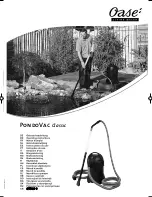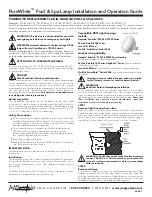
4.2 Grounding and Lightning Protection
WARNING Failure to install and connect an effective grounding system will greatly increase the
risk of lightning damage and will void your warranty.
We suggest you wire the grounding system
FIRST so it is not overlooked. The concrete footer of a ground-mounted array will NOT provide adequate
electrical grounding.
Surges induced by lightning are one of the most common causes of electronic controller failures in solar
water pumps. Damaging surges can be induced from lightning that strikes a long distance from the
system, or even between clouds. The risk of damage is greatly reduced if these instructions are followed.
Construct a discharge path to ground
A properly made discharge path to ground (earth) will
discharge static electricity that accumulates in the above-ground structure. This helps prevent the
attraction of lightning. If a lightning strike occurs at close proximity, a well-grounded conductive structure
can divert the surge AROUND the power circuitry, greatly reducing the potential for damage. The
ETAPUMP
controller has built-in surge protectors, but they help ONLY if the system is effectively
grounded.
Earth connection – Create an effective discharge path
It helps to picture this as a “drain field“ for
electrons. Here are suggestions for grounding, in order of their efficacy:
1. The best possible ground rod is a steel well casing located near the array. Drill and tap a hole to
make a strong bolted connection to the casing with good metallic contact. Bolt on a brass terminal
lug. After the connection is made, seal the connection with silicone sealant or other waterproof
compound to prevent corrosion. Protect the ground wire(s) from physical damage so they aren’t
stressed by being stepped on, etc.
2. Install a copper plate or other specialized grounding devices designed for the purpose. Some
systems use salts to improve the conductivity of the surrounding soil.
3. Install one or more copper-plated ground rods at least 8 feet (2.5m) long, preferably in moist earth.
Where the ground gets very dry (poorly conductive), install more than one rod, spaced at least 10
feet (3m) apart.
4. If the soil is rocky and doesn’t allow ground rods to be driven, bury BARE copper wire in a trench at
least 100 feet (30m) long. If a trench is to be dug for burial of water pipes, ground wire can be run
along the bottom of the trench. The wire size must be minimum #6 (16 sq. mm) or double #8 (10 sq.
mm). Connect one end to the array structure and controller. Or, cut the ground wire shorter and
spread it in more than one direction.
To achieve good grounding in a dry, rocky location, consult a local contractor who specializes in lightning
protection. It is best to plan the procedure in advance, and to coordinate the effort with other earth-
excavating procedures that need to be done. Reference: www.lightning.org
Bond (interconnect) all the metal structural components and electrical enclosures
Interconnect
the PV module (solar panel) frames, the mounting rack, and the ground terminals of the disconnect
switch and the controller, using wire of minimum size #8 (6mm2), and run the wire to an earth
connection.
Ground connections at the controller
The controller and junction box have redundant ground
terminals inside. They are all connected in common with the metal enclosures of both the controller and
the junction box. Ground connections can be made to any of these points.
Ground connections to aluminum
This applies to connections at the solar array framework, and at
the controller’s enclosure box. Connections to aluminum must be made using terminal lugs that have an
aluminum-to-copper rating (labeled “AL/CU”) and stainless steel fasteners. This will reduce the potential
for corrosion.
Summary of Contents for SunCentric P
Page 29: ...8 5 Exploded View of Pump...












































